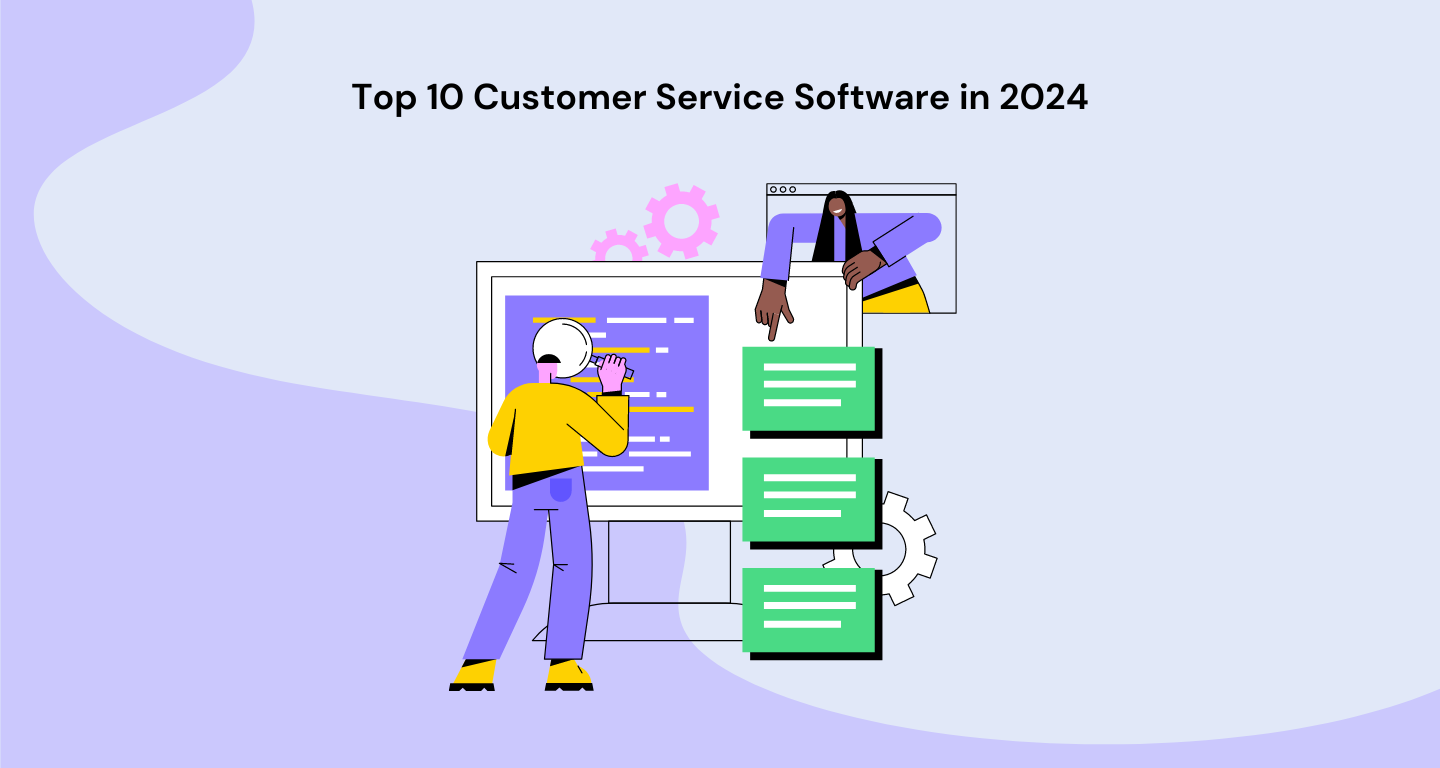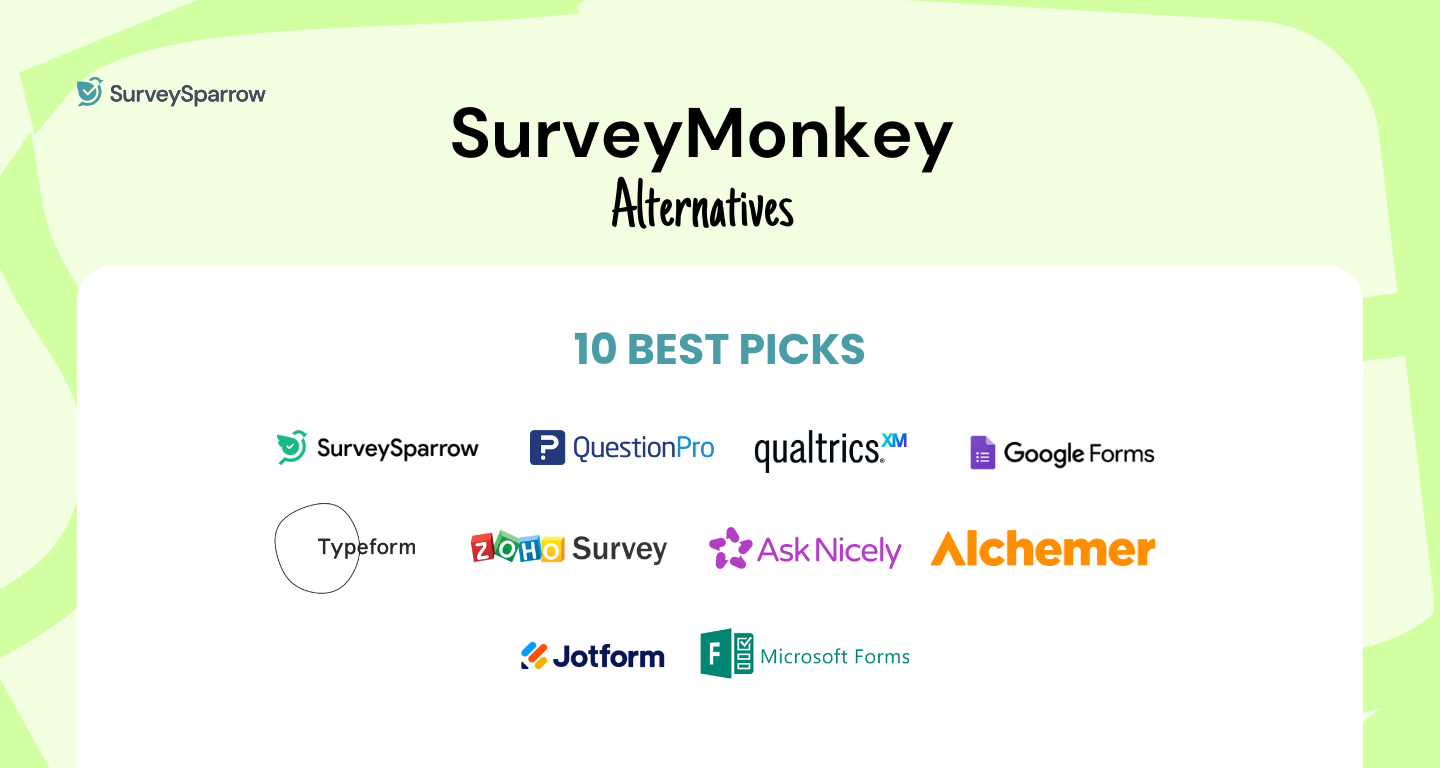You’ve probably heard of SurveyMonkey, a popular tool for creating surveys, but what if it’s not quite what you’re looking for? Maybe you’re on a tight budget, need more advanced features, or just want a different look and feel.
In that case, SurveyMonkey alternatives come in handy! There are plenty of great survey tools out there, each with its unique strengths.
Our aim is to help you find the perfect match for your needs. To begin with, in this guide, we’ll explore some of the best SurveyMonkey competitors out there. Now, let’s go over each tool in detail.
SurveySparrow: For engaging, conversational surveys that drive higher response rates & richer insights

SurveySparrow is more than just a survey tool. It’s a platform designed to make feedback collection as engaging and insightful as possible. Furthermore, its emphasis on conversational interfaces, coupled with robust features and excellent customer service, makes it a compelling choice for anyone looking to gather feedback efficiently and effectively. Where does SurveySparrow score?
- SurveySparrow offers engaging dashboards and insights, enabling intuitive and powerful data visualization
- It comes with a comprehensive library of more than 1000+ survey templates
- The tool is versatile as it can get. So whether you’re conducting Net Promoter Score (NPS) surveys, CSAT surveys, or need a chatbot for your website, SurveySparrow has you covered.
- With a variety of plans tailored to suit different needs, SurveySparrow offers great value. Plus, there’s a Forever Free Plan for those just starting out.
- SurveySparrow’s commitment to its users is evident in its responsive and helpful customer support team
- The tool lets users create surveys in seconds using AI survey builder. Tell your intent through a prompt, and your personalized survey will be ready.
Limitations
While SurveySparrow excels in user experience and design, those needing highly specialized data analysis tools might find it less comprehensive than some of the more research-focused platforms.
Ideal for
SurveySparrow is perfect for businesses of all sizes that value user experience and engagement. Its approachable interface makes it particularly suitable for customer feedback, product experience, and market research where higher response rates are desired.
Pricing: Starts at $19 per month. With ten different plans, ranging from Basic to Platform, SurveySparrow offers a variety of options to fit different needs.
QuestionPro: For academic researchers to market analysts

QuestionPro offers a user-friendly and robust alternative to SurveyMonkey, appealing to both novices and experts with its easy interface and comprehensive support Where does QuestionPro score?
- One of QuestionPro’s most compelling features is the ability to conduct unlimited surveys with unlimited responses, even on the free plan. This is especially beneficial for projects requiring extensive data collection.
- It offers advanced question types such as conjoint analysis and max diff, QuestionPro allows for more sophisticated survey designs that can provide deeper insights than standard survey questions.
- Available 24/7 via live chat and email, the support team is well-versed in the platform, ensuring users have the assistance they need, when they need it.
Limitations
While QuestionPro scores high on usability and support, some users have raised concerns about inconsistent pricing and challenges with specific integrations, which could be a consideration for those with complex needs.
Ideal for
With its versatile features, QuestionPro is suitable for a broad spectrum of users, from solo practitioners to large enterprises. It’s particularly favored in sectors like nonprofit management, education, civic organizations, health and wellness, and market research.
Pricing: Advanced plan starts at $85 per month. Free version available.
Qualtrics: For organizations & researchers who need a powerful, scalable solution for complex projects

Qualtrics stands out as a comprehensive platform for those looking for deep insights into customer, employee, product, and brand experiences. Indeed, its sophisticated environment distinguishes it as a top SurveyMonkey alternative for complex survey requirements. Where does Qualtrics score?
- Qualtrics goes beyond simple surveys, offering tools to capture, analyze, and act on data across various aspects of business and research. It’s designed to handle complex scenarios and deliver actionable insights.
- With powerful analytics and reporting capabilities, Qualtrics makes it easy to dive deep into your data. It offers advanced statistical analysis, predictive intelligence, and automated insights to help you understand the nuances of your data.
- From survey design to data collection, Qualtrics provides a high level of customization. Tailor your surveys with advanced logic, branching, and triggers to ensure you’re asking the right questions at the right time.
Limitations
What’s the catch Qualtrics’ advanced features come with a steeper learning curve and a higher price tag, making it potentially daunting for new users or smaller organizations with limited budgets.
Ideal For
It’s particularly suited for large enterprises, academic research, and any organization that requires sophisticated data collection and analysis capabilities. Qualtrics caters to those who need to conduct in-depth market research, employee engagement studies, and customer satisfaction surveys.
Pricing: For specific pricing, contact to get a quote.
Google Forms: The Go-To Tool for Simple Surveys

Google Forms might be simple, but sometimes simple is all you need. It is a go-to solution for many when it comes to creating forms and quizzes. This tool stands as a straightforward solution for many, prized for its ease of use and no-frills design, particularly appealing for those stepping away from SurveyMonkey’s complexity. Where does Google Forms score
- Google Forms lets you and your team work on surveys together in real-time. This is a game changer for group projects, where everyone can contribute simultaneously.
- If you’re already using Google Workspace, integrating Forms with Sheets or Drive is a breeze. This makes organizing and analyzing your data simple and efficient.
- You won’t hit a cap on how many surveys you can create or how many responses you can collect. This is a significant advantage over some of SurveyMonkey’s limitations on its free plan.
What’s the catch? The simplicity that makes it accessible means it lacks deeper data analysis tools, automation features, and the ability to manage responses in more sophisticated ways. This might leave professionals and corporations wanting more. Who will love Google Forms? It’s perfect for educators, small to medium-sized businesses, and anyone who needs to gather data quickly and without fuss. You can easily move your data to spreadsheets for further analysis, making it a handy tool for researchers and analysts too.
Pricing: Free.
Typeform: Accessible & Beautiful: SurveyMonkey Alternatives for Nonprofits

Typeform redefines the survey experience with its emphasis on design and user engagement. Known for its sleek interface and interactive elements, it stands as a vibrant alternative for creating surveys, quizzes, and forms. Why Typeform?
- Typeform’s standout feature is its beautiful, minimalist design that makes every interaction feel more personal and engaging.
- Typeform boasts a smooth, conversational flow. This approach keeps respondents engaged from start to finish, leading to higher completion rates.
- With Typeform, you can easily customize your forms to match your brand’s style. Plus, its wide range of question types and logic jumps allows for tailored survey paths that feel more relevant to each respondent.
Limitations
While Typeform’s design-focused approach is its strength, it may not offer the depth of analytics and advanced survey features that some users, particularly researchers or large enterprises, might need.
Ideal For
Typeform is a great choice for businesses and individuals who prioritize aesthetics and user experience. It’s particularly well-suited for marketing, customer feedback, event planning, and any scenario where engaging the audience is key.
Pricing: Starts at $25
Zoho Surveys: For user-friendliness and affordability

Zoho Survey finds a sweet spot between functionality and user-friendliness, offering a compelling choice for those seeking a balance between features and ease of use. Why Zoho Survey?
- If you’re already in the Zoho ecosystem, Zoho Survey will feel like home. It integrates perfectly with other Zoho tools, offering a smooth, unified experience.
- Zoho Survey presents competitive pricing plans that won’t break the bank, making it an attractive option for small businesses and individual users alike.
- Need people to take your survey? Zoho Survey provides access to Zoho’s own respondent panel, making it easier to gather the data you need.
Limitations
The survey logic can be basic and confusing for some users, and the interface, while functional, may not win any design awards.
Ideal For
Zoho Survey shines across various sectors like HR, education, healthcare, business, and more, thanks to its multilingual capabilities. It’s especially useful for those already using other Zoho products.
Pricing: Starts at $20 per month.
AskNicely: For those prioritizing NPS as a key metric for customer satisfaction

AskNicely is a powerful, focused tool for businesses serious about understanding and improving their Net Promoter Score, offering simplicity and efficiency in customer feedback management. Where does AskNicely score?
- Designed from the ground up for NPS, AskNicely provides specialized workflows to measure and improve your Net Promoter Score effectively, a stark contrast to the broader approach of SurveyMonkey.
- It allows for immediate notification and feedback, making it possible for businesses to quickly act on customer insights, address concerns, and boost engagement.
- AskNicely excels in delivering in-depth reporting and analytics that are tailored to understanding customer behavior and loyalty, featuring customizable dashboards and advanced segmentation.
Limitations
The platform’s multi-brand and template features can be somewhat limited and not as intuitive, and there have been mentions of minor bugs within its mobile application affecting data accuracy.
Ideal For
It’s particularly beneficial for service-based and home service companies looking to collect real-time feedback to improve service quality, customer retention, and, ultimately, revenue.
Pricing: Request for a Quotation.
Alchemer: For complex research projects and in-depth market analysis

Alchemer positions itself as a dynamic survey platform that goes beyond mere questionnaires to deliver powerful, actionable insights. With emphasis on customization and integration, Alchemer suits those who seek depth in their data collection efforts. Why Alchemer?
- Users can tailor almost every aspect of their surveys, from the look and feel to the logic and flow, ensuring that each survey perfectly aligns with their objectives.
- The platform excels in seamlessly integrating with a wide range of tools and systems, including CRM, analytics, and marketing platforms. This integration ensures that data flows smoothly across your tools, enhancing the overall utility of the insights gathered.
- Alchemer goes beyond simple surveys with advanced features such as sentiment analysis, data analysis tools, and enhanced security options, making it a powerhouse for those who need to dig deeper into their data.
Limitations
The platform’s breadth and depth, while impressive, can present a steep learning curve for new users. Additionally, the most powerful features come at a higher price point, which might not fit all budgets.
Ideal For
Alchemer is particularly well-suited for businesses, researchers, and professionals who require detailed feedback mechanisms and have specific needs that standard survey tools can’t meet. Its advanced features make it ideal for complex research projects and in-depth market analysis.
Pricing: Contact to get a quote
Jotform: When you want to tackle a wide range of tasks with minimal fuss

JotForm is a flexible and user-friendly platform that excels in creating forms for various purposes, from simple contact forms to complex surveys and registrations. Its adaptability and ease of use make it a preferred choice for individuals and businesses alike. Why JotForm?
- One of JotForm’s main attractions is its straightforward drag-and-drop interface, making form creation accessible to users of all skill levels without requiring any coding knowledge.
- With thousands of templates available, JotForm offers a head start on form design, allowing users to find and customize the perfect template for their needs quickly.
- JotForm integrates with a wide array of services, including payment processors like PayPal and Stripe, email marketing tools, and cloud storage solutions, facilitating a seamless workflow.
- Beyond its ease of use, JotForm provides advanced customization options, enabling users to create forms that perfectly match their branding and specific requirements.
Limitations
While JotForm is highly versatile, users with very specific or advanced data analysis needs might find its reporting and analytics features less comprehensive compared to more specialized survey platforms.
Ideal for
JotForm is well-suited for businesses, educators, and nonprofits seeking a reliable form builder for various applications, from gathering feedback and conducting surveys to event registration and collecting payments.
Pricing: Starts at $24 per month.
Microsoft Forms: For creating simple surveys, quizzes, and polls

Being part of the Microsoft 365 suite makes it a seamless choice for users already embedded in Microsoft’s ecosystem. With its simple interface and essential features, Microsoft Forms caters to educators, businesses, and individuals who need to gather information efficiently. Why Microsoft Forms?
- The tool stands out for its intuitive design, allowing anyone to create and share forms quickly without a steep learning curve.
- If you’re using Office 365, Microsoft Forms integrates smoothly with other Microsoft apps like Excel, making data analysis straightforward. This connectivity enhances productivity and data management.
- As responses come in, you can view data in real-time, enabling immediate insights and decisions. This feature is particularly useful for educators and teams needing quick feedback.
The Limitations
While Microsoft Forms is excellent for basic survey needs, its simplicity might be a limitation for users requiring advanced survey functionalities, such as complex branching logic or in-depth analytics.
Ideal for
Microsoft Forms is ideal for educators conducting quizzes, businesses gathering customer feedback, or any Office 365 user looking to create straightforward, no-frills surveys. It’s also great for event planning, internal employee feedback, and quick polls.
Pricing: Free





















